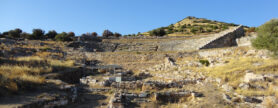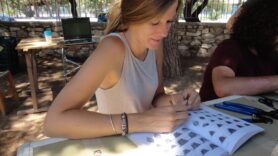Projects
The Thorikos Research Project
Floris van den Eijnde, Amber Brüsewitz, Alma Kant
 The mines of Laurion are a symbol of the Golden Age of Athens that lasted from 508/7 to 404/3 BC. With the silver from Laurion, the Athenian statesman Themistocles had a large fleet of triremes built that heralded the downfall of the Persian invasion of 480/79. The defeat of the Persians gave the Athenians dominance at sea, which gave them free rein in the Aegean and the eastern Mediterranean during the fifth century. During this period, Athens developed into the first true metropolis of Europe and attracted migrants from all over the world – from Thrace to the Levant and from Italy to Asia Minor – who found work in Athens and Laurion, as traders or craftsmen, as free citizens or as slaves. The latter group in particular found a hard life in the mines of Laurion.
The mines of Laurion are a symbol of the Golden Age of Athens that lasted from 508/7 to 404/3 BC. With the silver from Laurion, the Athenian statesman Themistocles had a large fleet of triremes built that heralded the downfall of the Persian invasion of 480/79. The defeat of the Persians gave the Athenians dominance at sea, which gave them free rein in the Aegean and the eastern Mediterranean during the fifth century. During this period, Athens developed into the first true metropolis of Europe and attracted migrants from all over the world – from Thrace to the Levant and from Italy to Asia Minor – who found work in Athens and Laurion, as traders or craftsmen, as free citizens or as slaves. The latter group in particular found a hard life in the mines of Laurion.Thorikos
But the history of Laurion and silver mining goes back much further than the fifth century. In the town of Thorikos, pottery fragments from the Bronze Age have been found in the mine shafts. These prove that silver was mined here early on. The impressive Tholos tombs near the classical settlement show that the inhabitants were relatively wealthy, undoubtedly thanks to the rich mineral resources. Verses from the Homeric Hymn to Apollo also suggest that there were early contacts between Laurium and areas overseas, in particular Crete.

Amber Brüsewitz studies pottery from Thorikos in the Museum of Laurion
Since 2011, Floris van den Eijnde has been conducting research into the settlement in Thorikos and mining in southern Attica in collaboration with Ghent University. Given the great importance of Thorikos for the history of the Athenian polis in the early Iron Age and in the Archaic period, the university will continue this project in the coming years. Read more about the Thorikos project on blogspotor Facebook.

